
The Light Returns to Tristram: A Diablo Retrospective - Article
by Issa Maki , posted on 16 October 2020 / 4,852 ViewsDiablo is one of the most important, inspirational games of its generation. What was once an identifiable bloodline has dispersed throughout the industry so prominently that it's barely recognized or acknowledged. Most people can't see the influence Diablo has had, because it's everywhere. In some fashion or another, almost everyone playing video games today owes it a debt they may never repay.
Going back for a visit would go a long ways to repaying that debt. With the release of Diablo on GOG, there hasn't been a better time to do so since Blizzard ended support for the classic Battle.net.
The game opens simply enough. Upon returning to their hometown of Tristram, a fledgling hero is implored by their former community to investigate the ruins of a desecrated church on the outskirts of the village. What unfolds next depends on the game more than the player themselves.
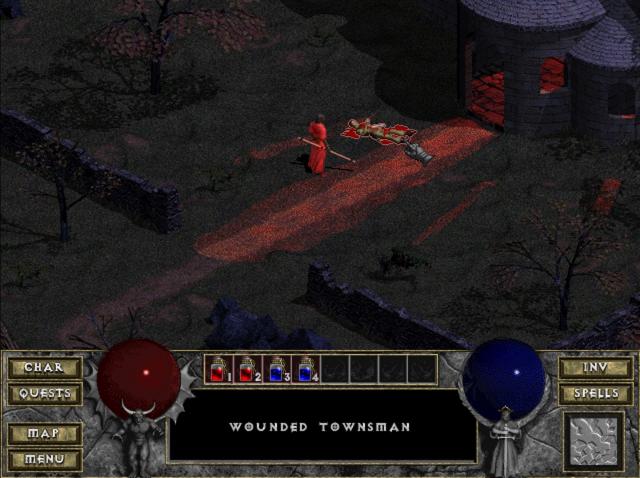
At first glance, Tristram's layout is easy enough to understand - blacksmith, healer, magic merchant, gambling, etc. What many may not be aware of is that hiding in plain sight are small examples of an influence that would be passed down through the ages. Experienced players will be looking for two details: the color of the water in the fountain and the status of the Wounded Townsman. For they reveal more about the current playthrough than they might seem to.
The quests in the single player mode of Diablo are divided into numerous (unseen) Quest Groups, of which only some are pulled from each category. If the water in the fountain is normal, Ogden the Bartender will give the quest for The Skeleton King. If the water is green, The Poisoned Water Supply quest will be assigned by Pepin the Healer instead. If the Wounded Townsman made it to the entrance of the church, he will ask the hero to slay The Butcher - at the cost of one of the two other quests in its group.
As each quests earns different rewards, certain ones are more beneficial to certain classes. The Undead Crown is essentially useless for Sorcerers, but for Warriors it enters the conversation about end-game equipment. Players fortunate enough to generate the quests for Arkaine's Valor or Lachdanan will hold a tremendous advantage over the evils of the labyrinth. Those that don't might not be aware of what they're missing. This creates a large portion of the game's replay value. Diablo simply cannot be experienced in its entirety during a single playthrough. By design, the game must be seen from multiple perspectives to view the bigger picture. What it reveals is a canvas that continues to be worked on today.
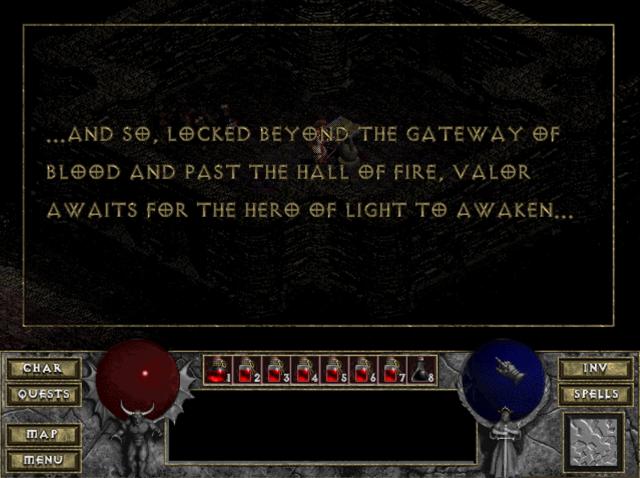
There are three character classes in Diablo: Warrior, Rogue, and Sorcerer. Each has their advantages, but in old-school RPG fashion they all have disadvantages that define their roles just as equally, if not more so, than the benefits.
This might not be noticeable at first, as each class can seemingly use any piece of equipment or spell they wish, as long as they meet the stat requirements. While this offers a degree of customization unique in the series, it ultimately binds the characters to the inescapable truths of what they are.
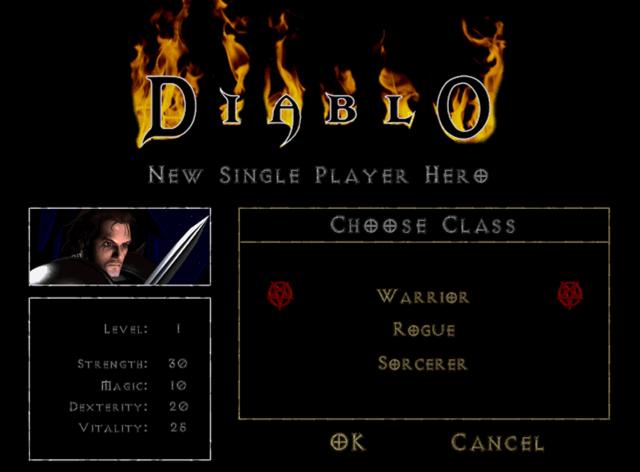
Also unique to Diablo is the fact that the stats for each class are capped at different levels. The Warrior can only have a maximum of 50 hard points in Magic. Therefore, he must rely on gear to boost his stats enough to learn higher levels of magic. Sorcerers can learn any spell without a second thought but, with a maximum Strength of 45, he will have different priorities concerning his armor.
For those looking to simply beat the game, it's hard not to recommend the Rogue. Her ability to learn mid-high level spells is respectable, and properly equipped she can also be effective in melee combat. A Rogue's true power comes from her high Dexterity stat, unlocking the potential of the bow. Raising Dexterity has a threefold effect: increasing bow damage, increasing chance to hit, and raising the character's natural Armor Class. Add to this her ability to distribute damage evenly between health and mana (via Mana Shield), combined with a penchant for ranged combat, and the end result is a versatile class that can adapt to a player's preferences and the increasing challenges the game presents.
Sorcerers are in a different boat, but follow a similar pattern. Often touted as the hardest class to effectively use, it's generally accepted that they're also by far the most powerful. His stat distribution is the simplest, with everything going into Magic, unless some Strength is needed for equipment. A Sorcerer's biggest weakness is his dependence on Books of Magic. Since spells are leveled up by reading the same type of book repeatedly, Sorcerers are much more reliant on drops than the other classes, especially in the opening stages of the game.
This is felt most harshly in single player, as its 'static' nature prevents dungeons from being repopulated, and vendors are slow to add new inventory (though starting a new game with the same character is an option). These are small prices to pay, as it's only a matter of time before a Sorcerer takes flight. Once they do, almost nothing in the game can ground them again. Almost.
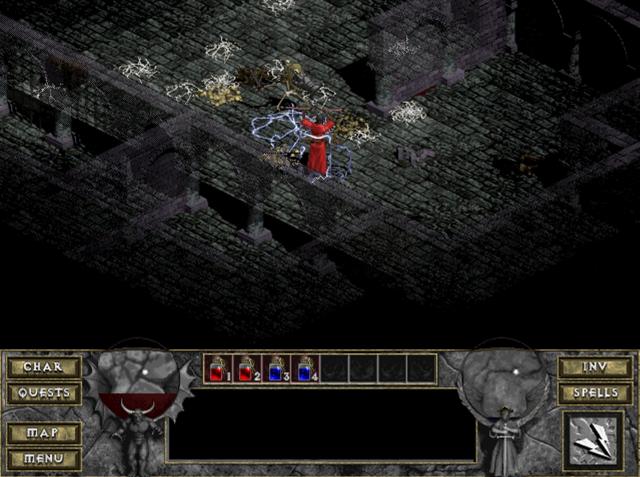
The Warrior is the most paradoxical of the classes, and easily the greatest challenge Diablo has to offer. The inverse of the Sorcerer, Warriors start off on a strong footing but quickly stumble into a potential free fall that they may not recover from.
It might not seem this way, as many of the single player quests favor him. The Butcher, The Skeleton King, Arkaine's Valor, and The Anvil of Fury are all tailor-made to meet his needs. This is because he has so many of them. Stat-wise, Warriors are encouraged to invest in all four attributes, yet this process will be entirely dictated by what they find in the field. Strength is a necessity for damage and equipment, though ample Dexterity is also needed to ensure that attacks will land with consistency. Vitality is vastly more important to Warriors than the other classes, but they can only afford to invest so much here. A fair portion of his points can be put into Magic too. Attack spells have few uses for him, but Stone Curse (51 Magic) and Teleport (105 Magic) are very helpful to his gameplan.
Despite the usual stereotypes associated with the class, Warriors have to play a thinking game the others don't need to concern themselves with nearly as much. There's a reason why Blizzard canonized the Warrior as the slayer of Diablo; beating the game with the class is the calling of a true hero.
Diablo's gameplay remains as timeless as ever. Inside of every room are the building blocks that became commonplace in the modern developer's toolbox: click on what you want to open/break/die, pick up any spoils and apply them to your character when applicable, raise attributes upon leveling up, repeat until fingers lose tensile strength. It never deviates from this formula, but its subtle complexities start to surface as the player makes their way further underground.
The most conspicuous of these come in the form of the various shrines randomly distributed throughout the early sections of the game. These can bestow numerous effects on your character and equipment, including the potential to permanently alter their base stats or spells. This power must be respected, as the damage shrines can do can be irreversible, but the benefits can allow for situations not normally possible, such as increasing durability on fragile gear or learning spells currently out of range. Those are rare examples of the early hardcore roots of RPGs that have been lost as time goes by, but they certainly aren't the only ones that exist - there are enemies who can also permanently affect your stats.
Qualities like these define Diablo, and it's this 'classic' style of gameplay that represents the largest obstacle for those returning to the town of Tristram; Diablo is a different genre of game compared to its children.
This is symbolized by the first steps the character takes. Diablo is the walk to Diablo II's run. It is what Alien was to Aliens, the Emilio Estevez to Diablo II's Charlie Sheen. The classic style can be difficult to readjust to, as the very concept of a role-playing game has shifted dramatically over the past few decades. The pacing is slow and deliberate and its scale much smaller. Every encounter is an intimate experience.
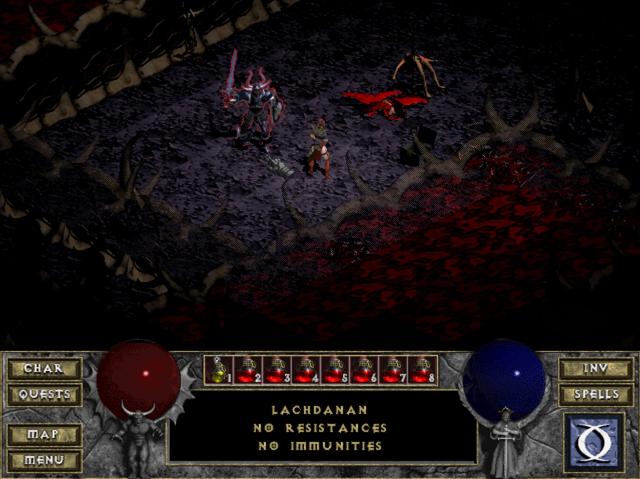
It might sound strange to hear, but using the environment to the player's advantage is a major part of the game's overall strategy. Success or failure can hinge on a properly utilized doorway or corner. The arrangement of barrels and chests can potentially be used for strong defensive positioning. Being able to recognize the importance of a sarcophagus might seem quaint by today's standards, as it hearkens back to a simpler time, when the corner at the end of the hallway was a blessing, not just the corner at the end of the hallway.
The equipment is another constant reminder. Don't expect anything resembling Enigma or set pieces with dozens of properties. You must appreciate items like a Jade Ring of Vigor or King's Sword of Vampires. This isn't to say that powerful equipment doesn't exist in Diablo - it's merely the power of the Turtle Hermit, not the God of Destruction. It won't seem like much compared to what we would see in its successors, but at least the smaller pool of items makes it more likely players will find something worth using. Griswold's Edge will never be Breath of the Dying, but on the right character it can feel as powerful as Azurewrath.
If there are areas where Diablo goes unchallenged, they're in the realms of storytelling and overall atmosphere. If there's one word over the years that has been used to describe the game more than any other it's “atmospheric”.
The idea that 1 town, 4 styles of dungeons, 6 musical tracks, and 9 NPCs could trump the game's sequels in this respect (let alone an 8th generation release) should be absurd, but it's a simple truth that is almost universally acknowledged by both fans and the internet in general. Diablo is the perfect example of less being more, with what little the game has being utilized to its fullest potential. The simplistic graphics, gameplay, and interface are tied together by masterful sound design. The twang of a bow and the sound of a broken skeleton's bones hitting the cold floor, or a gargoyle crumbling to dust, are more immersive than they have any right to be. The comfort Tristram's main theme can offer is almost indescribable, while the familiarity of the catchphrases from the various townsfolk are equally evocative. The most alluring of them all are the Tomes that may (or may not) spawn in the darkness.
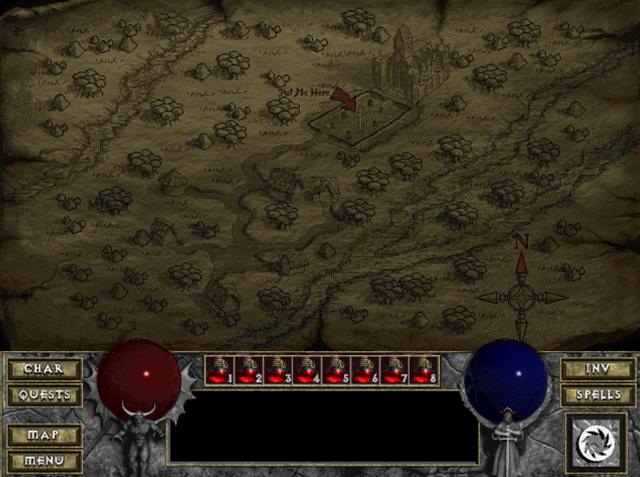
Diablo should get more attention for its storytelling. The basic set-up gradually gives way to a convoluted backdrop that no doubt inspired From Software's preference for indirect story presentation. The drawbacks are that there's no way to experience all of it in a single playthrough and most of the information comes from the Instruction Manual.
It's revealed that the realm of mankind is a mere playground for the warring Angels of the High Heavens and Demons of the Burning Hells. Exiled to the mortal world by their lieutenants, the triumvirate known as the Prime Evils began to wreak havoc across the land. Defeated, the three were imprisoned inside of magical artifacts known as Soulstones and banished to the recesses of the world.
Centuries pass, until the stone containing the Lord of Terror is discovered. Weakened, Diablo seeks to bide his time, waiting to posses a vessel powerful enough to aid him in freeing his brothers. To that end, the cathedral has become an irresistible temptation for those looking for the fortunes of the previously fallen, or the prestige gained in victory.
To go further into the plot would invite spoilers. Fortunately for us, the backstory in the booklet is fair game and is far more interesting.
Even longtime fans forget how much of the series' foundation was set by the original Diablo. The doomed assault on the Hellforge by the angel Izual; the creation of the Arcane Sanctuary by Horazon and his brother Bartuc (locations and characters from Diablo II); the roles of Belial, Azmodan, Duriel, and Andariel (Act Bosses of Diablo II and III) in the Dark Exile of the Prime Evils; the story of Baal's broken Soulstone, the potential consequences of Tal Rasha's martyrdom, and entombment in the Eastern deserts (as seen in The Lord of Destruction)... the list goes on. The backstory crafted here is so rich that Diablo IV is currently mining it for resources.
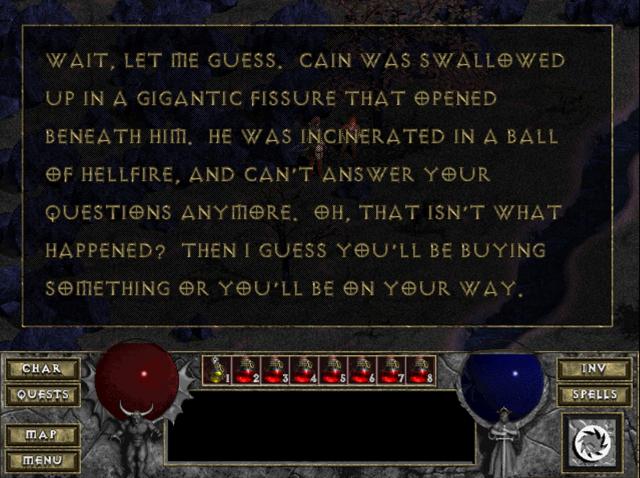
A personal favorite is a small passage explaining that the monsters populating the world are generated by the imagination of Diablo's tortured hosts. The implications of that idea within the game's world are not only fun to think about, but a luxury few releases these days would allow.
The wealth of information in the Librarius Ex Horadrim has long been forgotten in the decades since the manual's digitization, but a curious fragment remained - fully voiced recordings of them were put into the PlayStation version.
Perhaps more esoteric than the Librarius itself, many are unaware that a PlayStation port of Diablo even exists. More of a novelty than anything in 2020, it's still completely playable as long as gamers are willing to make the concessions expected from a console port of a PC game in 1998.
The most laughable of these is the amount of Memory Card space Diablo requires. Merely saving the game requires 10 of the available 15 Blocks, and 1 subsequent Block is needed for each character players wish to save. On top of that, the original version of Diablo runs at a 640x480 resolution, but the PlayStation port is even lower. If I knew what it was, I'd tell you, but I didn't know resolution figures could get that small.
That might not be the worst part. When a character completes a playthrough and goes to the next difficulty, every Unique item in their inventory is deleted. This would be a complete deal breaker if 85% of the best items in game weren't Magical. It's definitely a hindrance but, without the Hellfire expansion, the PlayStation version was the only way to play single player on Nightmare and Hell difficulties (due to a bug in the original game).
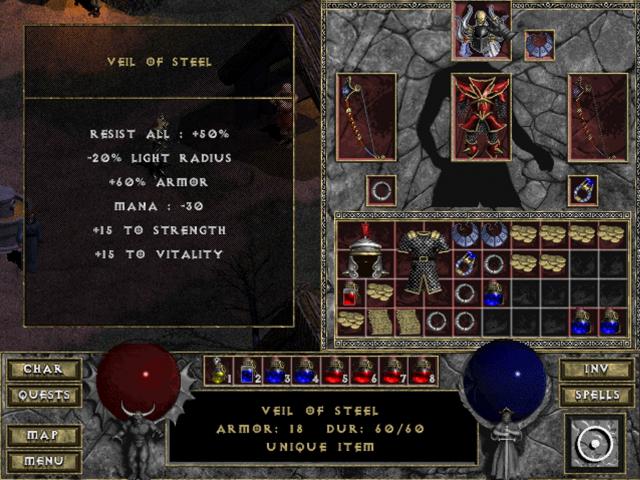
It wasn't all bad. The 'Fast Mode' feature is actually superior to Hellfire's 'Jog'. The controller set-up is surprisingly comfortable to use, with the shoulder-mapped potion buttons being a superior option to what came before. The lack of hotkeys and mouse is noticeable (particularly as a Sorcerer or using Teleport), slowing the action in an already slow game even further, but the proof of concept was there.
While certainly antiquated, the PlayStation port of Diablo should be remembered more fondly than it is. It proved there was an appetite for the series on home consoles, and the five subsequent releases of Diablo III show that people are still hungry. With the difficulty bug and closure of Battle.net, there was a brief time in history when the PlayStation version was my preferred way to play the game. I'm delighted to say this is no longer the case.
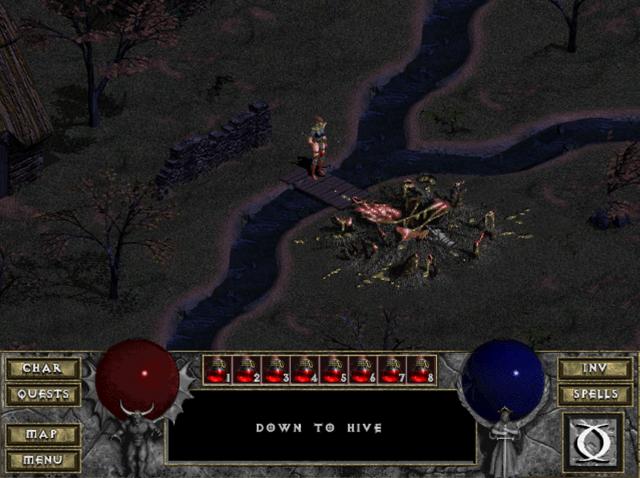
In 2019, Blizzard teamed up with GOG to digitally release Diablo alongside its expansion, Hellfire, for the first time ever, and the final product is the most solid release of the game available.
The most exciting aspect is obviously Hellfire, the third-party expansion developed by Synergistic Studios, a defunct subsidiary of defunct company Sierra. Undoubtedly the black sheep of the series, Hellfire adds a number of new weapon suffixes, spells, and quality of life improvements, along with almost two dozen new enemy types, two new areas, and a new character class, the Monk. Two unfinished classes (Bard and Barbarian) and additional features can be accessed by the more ambitious minded. The ability to change difficulties in single player is worth the price of admission alone, something that can't be said of the multiplayer.
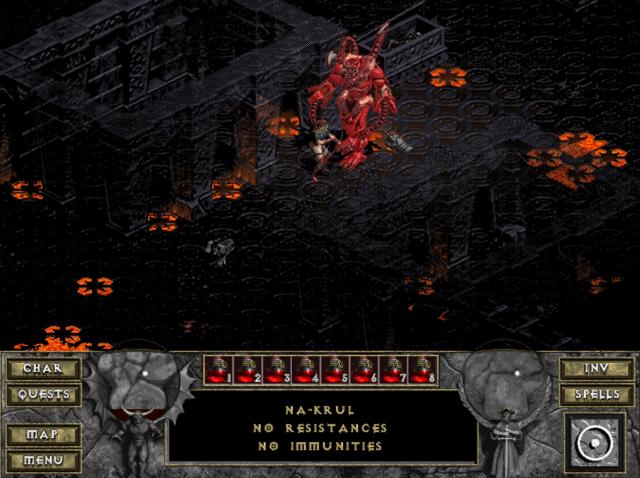
Beyond all probability, Blizzard and GOG were able to resurrect the first incarnation of Battle.net, a feat that in and of itself is worthy of merit. While technically playable, the derelict still requires users to open ports on their modems to connect, essentially compromising their computer's security.
Either way, there's virtually no reason to do so. During his brief sojourn online, LanceManion was unable to find one other player in a game or in the numerous chat channels. LAN connections are still an option, so multiplayer Diablo is still on the table for the truly devout. It was nice to see the old Battle.net again for nostalgia's sake, but there truly is no going back home again.
That's alright, because we now have the best version of one of the greatest games of all time. Though its successors have usurped it in terms of popularity, generations of new gamers will continue to be influenced by it in ways they may never know. Should they ever get curious, the old guard can rest assured knowing that Diablo is more accessible than ever before, and is just as fun as they remember. And those of us who have never left can still be found at the tavern, rambling on to anyone willing to listen.
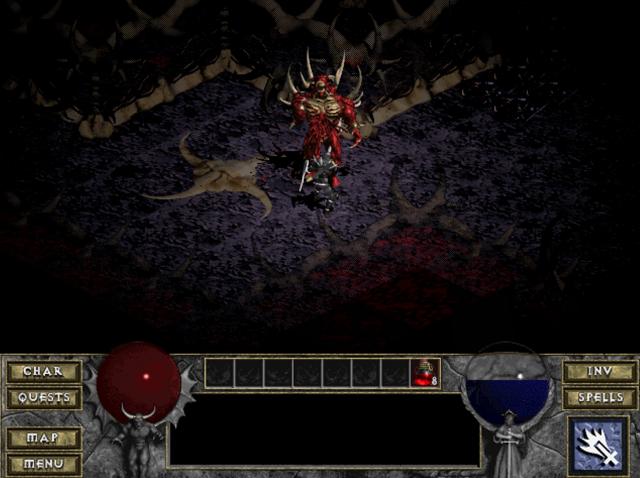
For your sake, and that of gaming history - be curious!
More Articles
Masterpiece, this game and Diablo II paved the way.
What a great in depth look at Diablo, so many things I've forgotten over the years. I still have my instruction booklet from when I purchased the game in 1997. The illustrations and the lore in it set a very high standard that's never been met by any other company.
My favorite game franchise









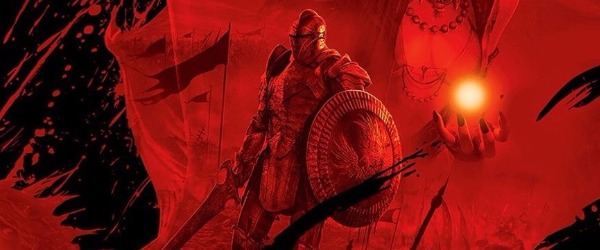
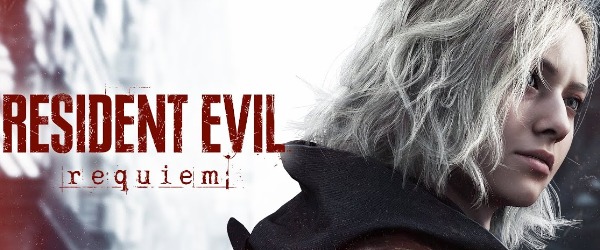
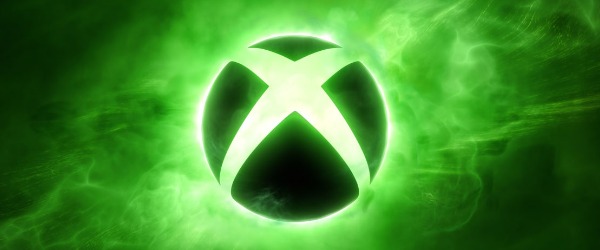










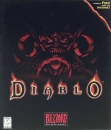

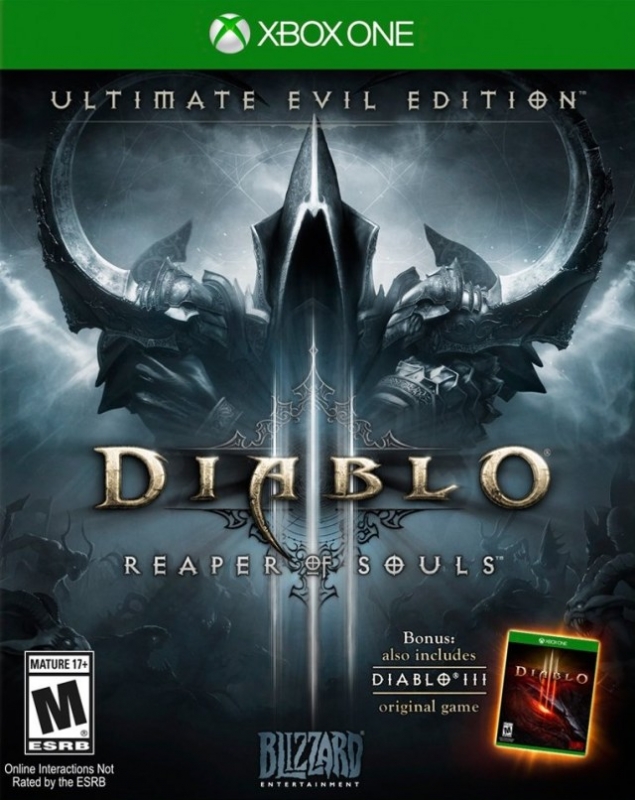

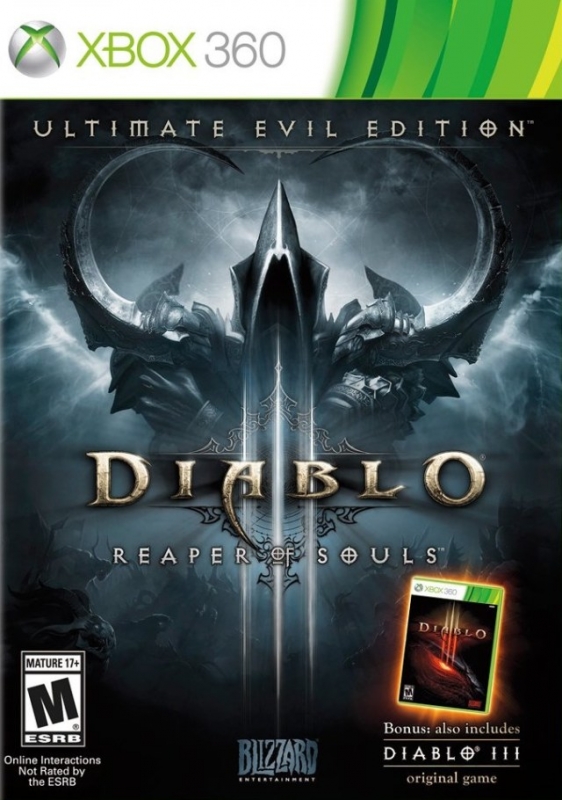

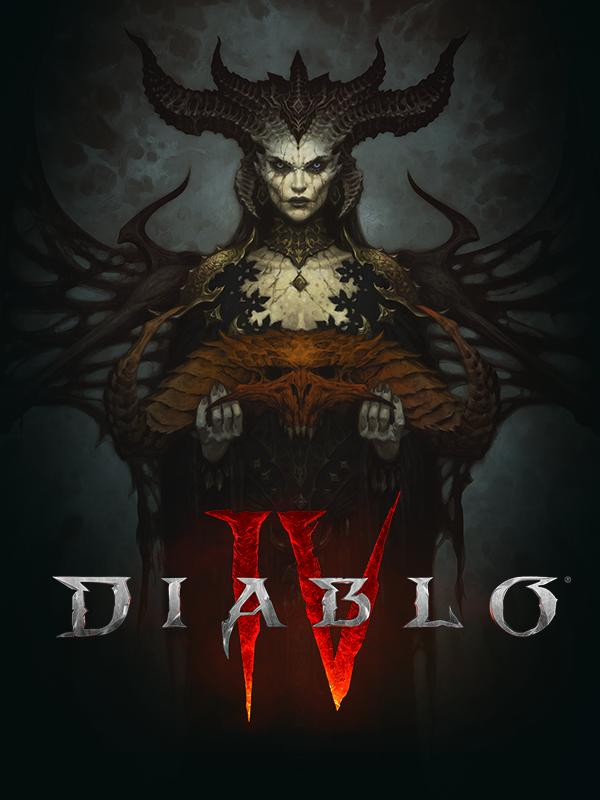

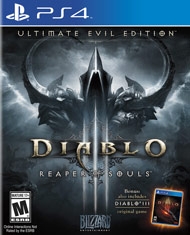
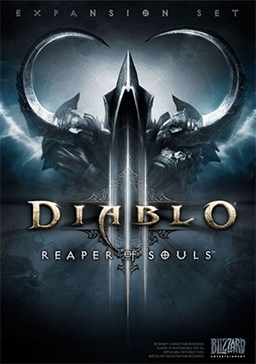
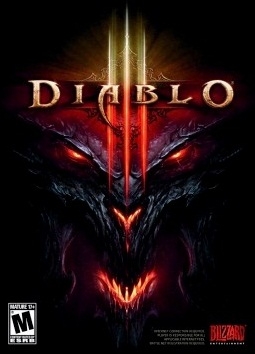
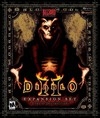
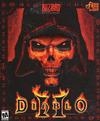
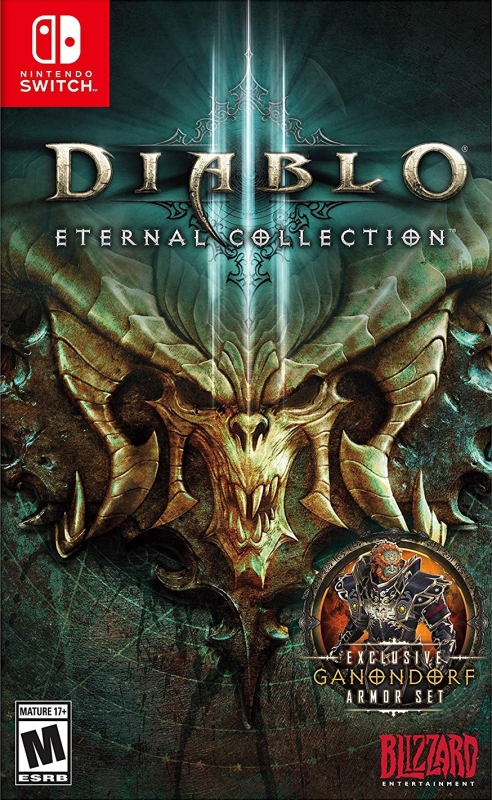

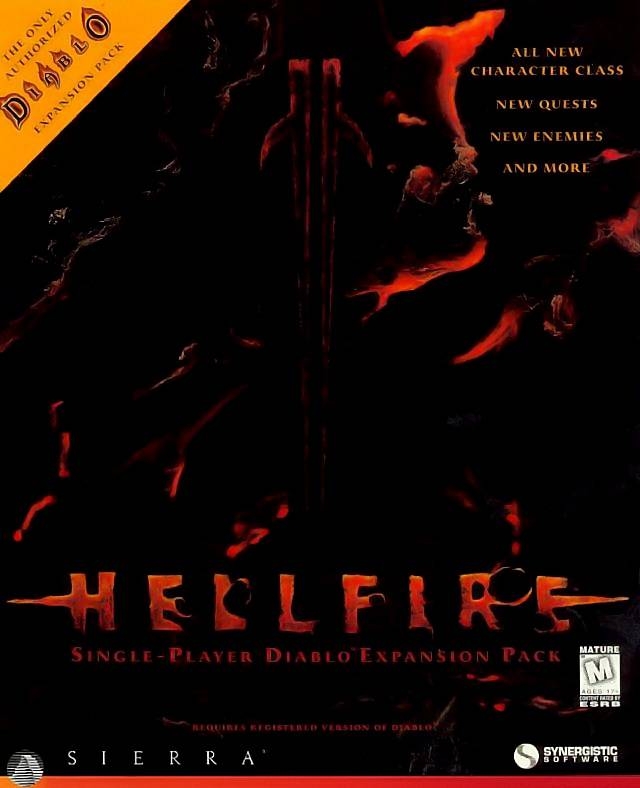
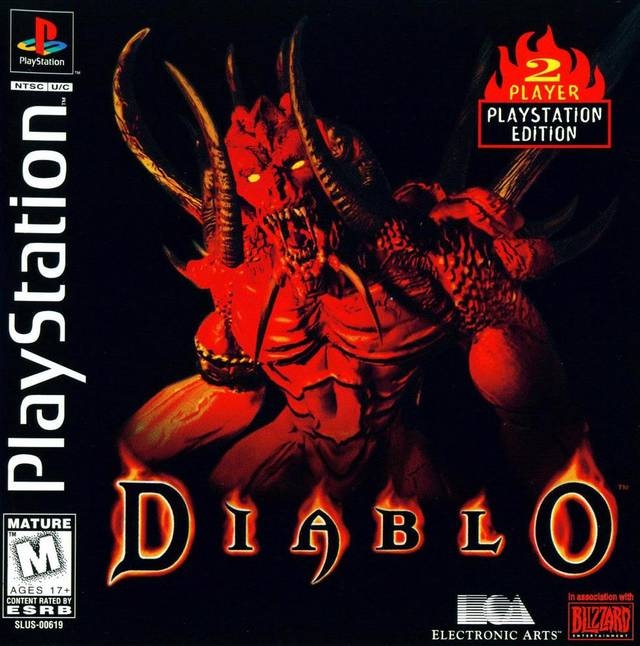



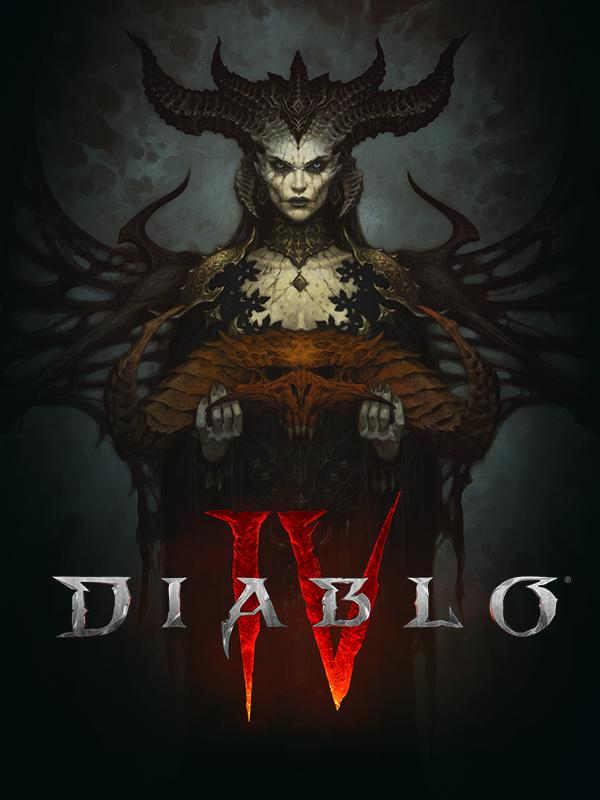
 Essay Pro
Essay Pro